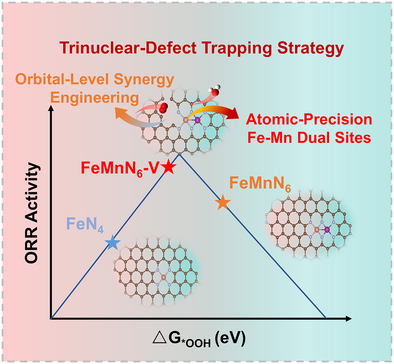Defect-Triggered Orbital Hybridization in FeMn Dual-Atom Catalysts Toward Sabatier-Optimized Oxygen Reduction
Graphical Abstract
A defect-engineered heteronuclear FeMn dual-atom catalyst on a porous N-doped carbon matrix is synthesized via a customized trinuclear-defect trapping strategy. The defect-mediated coordination strengthens Fe 3dz2 with O 2p orbital hybridization, optimizing adsorption energy toward Sabatier optimality. The catalyst delivers a 0.921 V half-wave potential for alkaline oxygen reduction and excellent Zn-air battery performance.
Abstract
Dual single-atom catalysts (DSAs), leveraging synergistic dual-site interactions, represent a promising frontier in electrocatalysis. However, the precise synthesis of dual-atom pairs and fine-tuning of their electronic structures remain significant challenges. Herein, we construct a defect-engineered heteronuclear FeMn-DSA anchored on a porous nitrogen-doped carbon matrix (FeMnDSA/dNC) through a customized trinuclear-defect trapping strategy. This defect modulation strategy effectively stabilizes dual atomic pairs while optimizing electronic structures to approach Sabatier's optimality, significantly boosting oxygen reduction reaction (ORR) performance. The FeMnDSA/dNC achieves a high half-wave potential of 0.921 V in alkaline media, with assembled zinc-air batteries demonstrating 291 mW cm−2 peak power density and stable charge/discharge cycling for over 500 h. Theoretical calculations reveal that defect-mediated coordination adjacent to Fe-Mn diatomic centers triggers charge redistribution, suppressing antibonding orbital populations while strengthening Fe 3dz2 with O 2p orbital hybridization. This modulation weakens O─O bonding through optimized *OOH adsorption configurations, thereby enhancing ORR kinetics. The present work provides valuable insights into the precise modulation and the underlying mechanisms of DSAs, advancing the design of electrocatalysts for energy storage and conversion applications.
Conflict of Interests
The authors declare no conflict of interest.
Open Research
Data Availability Statement
The data that support the findings of this study are available from the corresponding author upon reasonable request.





